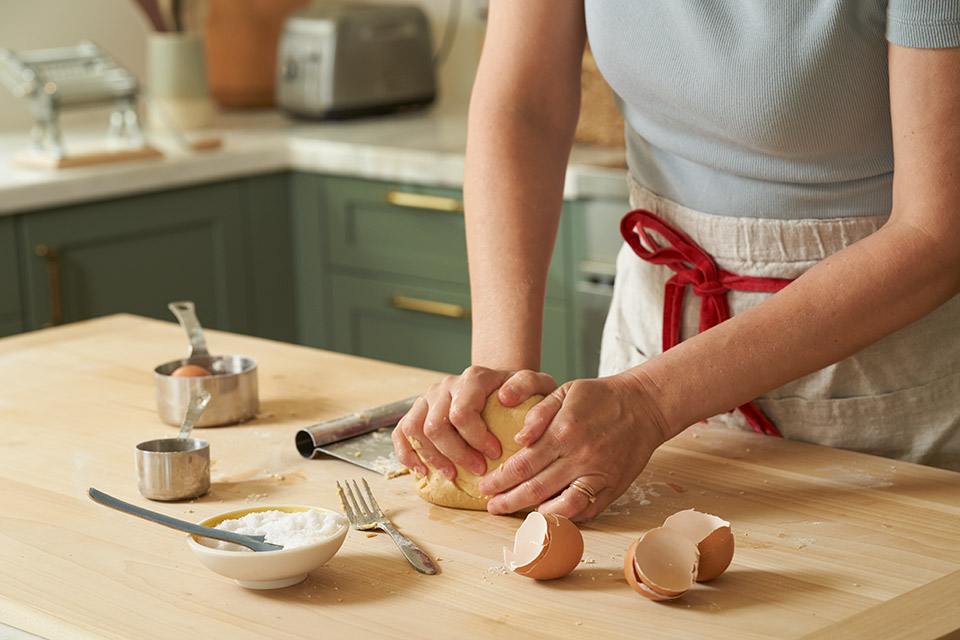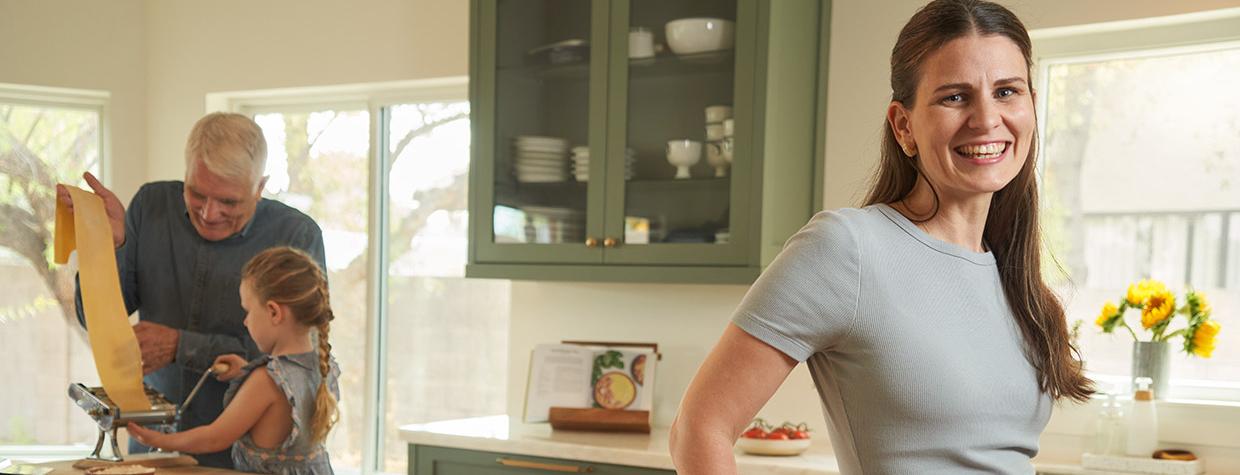Food is in Emma Zimmerman’s genes. To anyone who knows her family, it might seem logical that she would launch the second iteration of the Hayden Flour Mill with her father. You could even call it destiny — even though it took her a while to recognize it. But while Emma was traveling a different path, that destiny eventually caught up with her.
In 2011, Emma joined her father, Jeff, in relaunching the iconic brand as Hayden Flour Mills, using grains and a process that honor the original mill’s history. Opened by Charles Trumbull Hayden in 1874, Tempe’s historic mill gave life to a small agricultural town and a name to Mill Avenue. In 1998, it closed after more than a century of continuous operation. But its spirit lives on in Queen Creek, where the Zimmermans process flour using a stone mill to retain the nutrients and flavors of heritage grains.
Their products have been featured in Bon Appétit, Food & Wine, Christopher Kimball’s Milk Street and Forbes. In 2014, Martha Stewart Living selected the dynamic duo from among more than 3,000 entrants for one of 10 American Made Awards. And this year, Emma’s cookbook, The Miller’s Daughter, was nominated for a James Beard Award.
Emma was born and raised in Arizona, and growing up, much of her family’s life revolved around food: Her mother, Maureen, a registered dietitian, taught nutrition at Mesa Community College, and her maternal grandmother, Barbara Colleary, was Arizona culinary royalty. The former director of the Careers Through Culinary Arts Program, Colleary was inducted into both the Arizona Culinary Hall of Fame and Les Dames d’Escoffier, a by-invitation society of high-achieving women in the food, beverage and hospitality industries. (Emma is now a Dame herself.) In 2002, the Scottsdale Culinary Festival awarded Colleary its Lifetime Achievement Award.
Emma grew up helping her grandmother do cooking demonstrations at Hackett House — Tempe’s first bakery, just down the road from the landmark flour mill. There, Colleary volunteered with Tempe Sister Cities’ Passport to the World program, which teaches kids about other countries through culture, arts and food. Jeff and Maureen also hosted international students from Arizona State University. “So, we also had that exposure to a lot of different foods from other cultures,” Emma says.
While the younger Zimmerman kids played sports — her sister Camille, for example, became a professional basketball player — the older siblings, including Emma, were “very nerdy,” she says. Music was a big part of their life: Emma played flute, while her older brother played violin. And they loved exploring languages, attending Japanese Saturday school and studying Latin with a tutor.
Family dinners were legendary. “My mom always made these amazing dinners,” Emma says. “And then, as we got older, the meals got a little more gourmet and fun.” Jeff was the tinkerer, always trying new things. He experimented with fermenting and loved baking different breads. One Easter, he steamed a ham in hay. “It smelled up the house like a farm,” Emma recalls with a laugh.
The family’s culinary enthusiasm continues today. “My parents are hilarious,” Emma says. “They visit my sister in Seattle and come home with a suitcase full of pickling cucumbers. Or we go on vacation and they bring all the ingredients with them because we can’t possibly be without a good meal.”

Hayden Flour Mills someday. | David Zickl
Emma loved following her dad around. Having grown up on a farm in North Dakota, he was good with machines and could fix anything. “I loved hanging out and seeing how things worked,” she says. But when it came time for college, she studied bioengineering, earning her bachelor’s and master’s degrees from ASU. Then she enrolled in a doctorate program in neuroethics at McGill University in Montreal, with the goal of working as a hospital ethicist.
In Montreal, Emma enjoyed learning about French food, but she struggled. Winter was long and hard, and she experienced seasonal depression without understanding what was wrong. She started baking as a way to deal with the stress. Meanwhile, Jeff had started milling his own flour and had begun thinking about reviving the Hayden Flour Mill name. He researched the original mill and started investigating heritage grains.
In the 1960s, the so-called “Green Revolution” introduced high-yielding dwarf wheat varieties. These modified strains dramatically increased production, but at the cost of genetic diversity and flavor. The new varieties also required large amounts of fertilizer, pesticide and herbicide. Flour production had industrialized, too, with stone-ground milling — which the original Hayden mill used — giving way to steel rollers that produced highly refined white flour quickly and cheaply. Jeff became convinced something had been lost.
“When you make artisan sourdough, there aren’t that many ingredients,” Emma says. “Most of the flavor’s coming from the flour. So, that was his hypothesis.”
About that time, Emma made the difficult decision to quit school and come home. Living in her parents’ basement, she taught biology classes at Phoenix College and a cadaver lab. “[The lab was] at night,” she recalls. “It was just really creepy. And I didn’t feel like I was thriving.”
Looking for something different, she thought she might help Jeff with his project. Just for a little while.
Jeff famously rented a table at a Local First Arizona conference and displayed a sign that said he was looking for farmers who wanted to grow heritage wheat and chefs who wanted to use the flour. A number of small mill startups around the country were stone-milling heritage grains, and famed Phoenix-area restaurateur Chris Bianco had been buying flour from one of them and was looking for a local source. His brother Marco was at the conference; so was Pamela Hamilton, founder of Edible Phoenix. Both would help relaunch the brand.
Bianco offered a room in the back of his Pane Bianco restaurant, free of charge. In 2011, Jeff ordered a 32-inch Austrian stone mill. When the 1,600-pound mill arrived, they had to dismantle the door to get it into the building. “[Marco says] we were like the Egyptians moving a giant stone,” Emma recalls. “And [Bianco] was probably like, Oh, wait. What did I sign up for?”
The next hurdle was finding grain. Ethnobotanist Gary Paul Nabhan helped them secure seeds of White Sonora wheat, a drought-tolerant variety introduced by the Spanish in the 1600s. Steve Sossaman, a family friend, offered to grow them on 30 acres of his Queen Creek farm, and all the pieces were in place.
The first harvest was memorable: Emma gathered up a bouquet of that first wheat, and it became her wedding bouquet a few months later. And Jeff commissioned Bianco’s father, Leo, to paint a portrait of Emma from a picture someone made of her surrounded by the wheat.

The business side was not all halcyon skies and amber waves of grain, though. Emma, who did the milling, discovered she had an allergy to wheat dust. And while the family originally planned to mill exclusively for Bianco, it was quickly apparent that using only their flour wasn’t going to pencil out for a pizzeria.
But other local chefs walked through the back door, and some became customers. A buyer from Whole Foods also came calling. And American Airlines’ magazine featured the business in an article, which proved a mixed blessing. “We had people showing up at Pane Bianco and ordering online, and we barely even had an online store,” Emma recalls. “We were like, ‘I don’t know. You’re here.
I guess you can come see.’ ”
And there were endless challenges getting and processing grain. One supplier farmed on vacant tracts all over the city. “I had to meet him under an overpass and get the [grain] from him,” Emma recalls.
Often, there was not enough or too much, or there were bugs or weeds mixed in. To make an early order, Emma picked the weeds out by hand. One year, a farmer planted wheat in a field where alfalfa had grown the year before. The alfalfa came back and mixed with the grain, and the whole crop was lost because the smell of alfalfa infused the wheat.
The mill eventually outgrew Pane Bianco and moved to a larger facility on Sossaman’s farm. The Zimmermans hired a miller, expanded their varieties of grain and introduced products such as pastas and crackers. After a pause, they are again experimenting with different grains, including Sin El-Pheel, grown in ancient Iraq, and Pacific Bluestem.
And, for Emma, things feel as though they’ve come full circle. She never got to write her dissertation, but she did write The Miller’s Daughter. At the time this story went to press, Don Guerra of Barrio Bread in Tucson was making plans to come to the Hayden Flour Mills retail space in Gilbert once a week, beginning in the fall. Recalling the early days at Pane Bianco, the Zimmermans had to knock down a wall to get Guerra’s oven into the bakery.
And Emma’s daughter, Sonora, now follows Jeff around as he fixes things. She loves baking bread with her grandfather and tells Emma she’s going to work for the mill. “We’ll see,” Emma says with a laugh. “She’s 5.”
To learn more about Hayden Flour Mills, call 480-557-0031 or visit haydenflourmills.com.
PURPLE PICKLED EGGS
When you are draining cooked purple barley, don’t throw out the cooking liquid. Its vibrant purple color makes these simple pickled eggs pop.
Ingredients
1 cup Tibetan purple barley cooking liquid
½ cup granulated sugar
1 cup apple cider vinegar
1 teaspoon fine sea salt
6 hard-boiled eggs, peeled
Procedure
Combine the barley cooking liquid, sugar, vinegar and salt in a small saucepan over low heat. Bring to a boil and simmer for about 5 minutes until the sugar has dissolved. Remove from the heat and allow to cool for a few minutes.
Place the eggs in a glass jar, then pour in the pickling liquid.
Cover and refrigerate for 24 hours before serving. The eggs will keep in the fridge for up to three months.
— Excerpted from The Miller’s Daughter, by Emma Zimmerman

